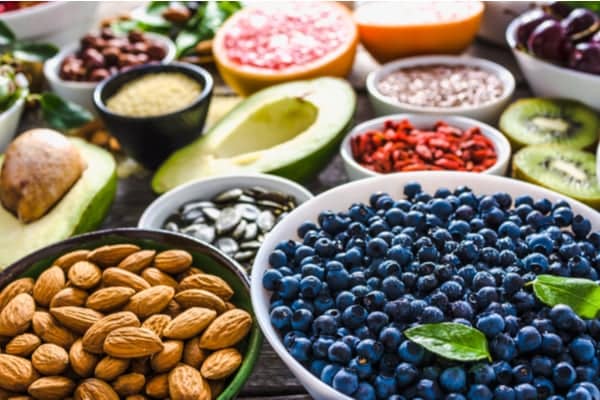“A healthy lifestyle” is an all-encompassing term that has expanded over the years as we gain more insight into the different elements that play into holistic health.
In addition to making exercise and physical activity a cornerstone of your weekly activities, a healthy lifestyle also includes hygiene, sleep, setting personal and work boundaries, resting, and, of course, eating the foods that meet your body’s needs and improve your well-being.
Even though the concept of a “diet” is meant to refer simply to a person’s eating patterns, restrictive diet culture has co-opted this term, and it now communicates the consumption of specific kinds of foods in controlled quantities with the goals of achieving weight gain, weight loss, or, in some cases, a therapeutic goal related to specific illnesses.
For most people, however, continuing on your health journey means adopting a set of food and nutrition habits that often seem like small changes but can make a big impact on your lifestyle.
Here, we offer ten concrete food and nutrition habits that you can integrate into your practice with your clients or even into your own life!
{{cta(‘8c7c8cff-00e5-4cb0-844a-5352a5b5029f’)}}
10 Food and Nutrition Habits that Contribute to Your Health
Changes in what you eat don’t need to be revolutionary for the way you feel to be revolutionary. Here are ten ideas for making small shifts in your food and nutrition habits that can help contribute to a healthy lifestyle.
Stock Your Fridge
What foods go in the fridge? Fresh foods with an expiration date, like fruits, vegetables, fresh salsas, protein-rich foods, and foods with healthy fats.
Foods that go in the fridge are often the base of recipes you make at home. So, rather than having a moment where you look into an empty fridge and decide to order takeout, you’ll see a world of possibilities before you.
Make an effort to eat mostly fresh foods from your fridge for a few days, and you’ll begin to feel completely different. If you don’t like to cook or are short on time, here are several ideas for nutrient-rich, no-prep or easy-prep foods for every meal of the day.
Of course, there are plenty of healthy, nutrient-dense foods that are not typically stored in the fridge or freezer. However, the idea is to motivate you to step away from ultra-processed foods’ temptation and choose fresh foods instead.
Hydrate
You know you should be drinking plenty of water daily, but do you or your client really meet your hydration goals?
In general, you should aim to drink 8 to 10 glasses (2 to 2.2 liters) of water a day, but this amount increases if you exercise, are a bigger person, live in a warm climate, tend to sweat more than average, or are ill.
Water helps your body regulate internal temperature, lubricates and cushions joints, and protects your spinal cord and other tissues. It also helps to eliminate waste, including toxins, through urination, sweating, and bowel movements.
Additionally, if you aim to lose weight or control your appetite, research shows that drinking water before meals helps reduce food intake.
Plan to Snack
Is snacking part of a healthy lifestyle? It all depends on what you snack on and why you snack.
If you choose nutrient-dense snacks between meals, it can help meet your nutrient requirements and keep you energized and focused throughout the day. However, making a habit out of eating ultra-processed packaged snacks that are nutrient-poor as a response to anxiety could impact your mental and physical health.
If you tend to get hungry between meals and aren’t eating enough throughout the day, snacking could very much be part of a balanced diet.
What’s the key? Plan your snacks. If you tend not to have time to prepare them, choose grab-and-go whole foods, like fruits, veggies, and nut butters, or take some time in the evenings or weekends to snack-prep. That way, you are mindful of what you are eating and how much you are eating for your snacks.
Pro tip: Get to know your cravings. If you tend to crave something sweet in the mornings and salty in the afternoons, make sure your planned snacks mirror these cravings.
Embrace the Rainbow
From a nutritional perspective, foods that are naturally different colors provide a range of vitamins, minerals, and phytonutrients that support your overall health.
Green leafy vegetables, broccoli, kiwi, green grapes, avocados, green bell peppers, green tea, and algae are all packed with antioxidant phytonutrients, fiber, vitamins and minerals, and plenty of other nutrients that support the immune system and keep organ systems working properly.
Blue and purple fruits and vegetables, like blueberries, grapes, and purple cabbage, have antioxidant anthocyanins, vitamins C and K, and the mineral manganese, among plenty of others.
Red fruits and vegetables, like tomatoes, strawberries, and beets, have plenty of lycopene, which is a phytonutrient with anti-cancer properties.
You can learn more about what the color of your food says about the food’s nutrient properties here.
Aim to eat a variety of foods every meal to “eat the rainbow,” and you’ll be adding a nutrient-packed punch to every bite.
Embrace Healthy Fats
Long gone are the days when we thought all fats were bad for our health. Not only is fat essential for the healthy function of our brain, joints, and heart, it is also found in plenty of foods that provide other essential nutrients.
While some saturated fats can also be part of a balanced diet, they tend to be rich in Western eating patterns. Unsaturated fats (monounsaturated and polyunsaturated) tend to be lacking in our diets. These fats help reduce heart disease risk, promote brain and eye health, and support the immune system.
Embrace foods that are rich in healthy fats, like avocados, fatty fish, nuts and seeds, and minimally-processed plant oils, like olive oil and avocado oil.
Avoid trans fats, which are mostly found in ultra-processed foods, as the consumption of this type of fat is linked to multiple chronic diseases.
Get to Know Your Food
Make a habit of learning about the food you eat. If they are fresh foods, be aware of the macronutrients, micronutrients, and other components they have and how they influence your health. If you are eating packaged foods, make a habit of reading the nutrition facts label, and understand what it is trying to tell you.
However, what is most important is to keep in mind that your eating patterns are not defined by single foods but by what you normally eat in quantity, quality, and diversity. So, as you think about one food you are eating, consider how it fits into your overall diet and whether it is filling your nutrient needs.
Moderate UFP Consumption
Ultra-processed foods (UPF) are what we usually call “junk” food but with a clearer definition.
Eating UPF every once in a while can surely be part of a healthy lifestyle when you are mindful of what you are eating overall. The key is to ensure that most of the foods in your diet are whole foods and minimally processed, as these habits are linked to lower risks of chronic diseases.
We’ve put together a blog post with several ideas for healthy and delicious alternatives to UPF.
Take Your Time
Between work, post-work activities, and life obstacles, it can be challenging to find a time to sit down and enjoy your meal.
Even when your life is always in motion, try to take a break from this rhythm at your meals. When you eat slowly, you are more likely to eat less and stay satisfied between meals.
Additionally, sharing meals with family and friends opens up the opportunity for social connection, a cornerstone of mental health.
Put the Phone Away
There are several problems with the central role smartphones have taken in our lives. Chronic smartphone use is associated with more alcohol consumption, mental health issues, academic issues, and increased impulsivity. Among those problems is the way it affects our mealtimes.
When we use our smartphones during mealtimes, we often disconnect from what we are eating and who we are eating with.
Make sure you finish checking your messages before sitting down to eat and take time to fully enjoy your meals.
Stock Your Fruit Bowl
Whether in your office or at home, keep out a fruit bowl in the kitchen or on the dining room table. If you feel a craving coming on and fresh, appetizing-looking fruit is handy, you’ll be more likely to grab a piece of fruit instead of looking in the pantry for chips and cookies.
Not only is fruit full of vitamins, minerals, and antioxidants, it is also full of complex carbohydrates and natural sugars to keep you satisfied and give you an energy boost.
Bonus Tips
Many small changes add up to make a big difference. However, just as there are some easier ways to make changes in your nutrition, health, and well-being, some bigger changes take a bit more effort.
Below are three more bonus tips that, while they may take a bit more work to modify your mindset and lifestyle, the potential benefits make the effort worth it.
Ask Yourself: Are You Truly Hungry?
Are you really hungry? It is not uncommon to turn to food to deal with emotions like boredom, sadness, and anxiety. Social, psychological, and biological factors can affect our ability to tell whether our bodies are asking for food or whether we have some other unmet need.
This is a useful chart that can help you identify whether you are really hungry.
If you want some more helpful information on the science of appetite and hunger, read this blog.
Be Mindful of Your Alcohol Consumption
It’s not uncommon for health-conscious people to indulge in a drink now and then, and if it is done mindfully, it generally doesn’t pose a problem.
However, many drinks and cocktails are very high in simple sugars and are void of nutrients, not to mention alcohol consumption is linked to several health issues in the long and short term, including engaging in risky behavior, high blood pressure, weakening of the immune system, and depression and anxiety, among others.
If you do not drink, there is no reason for you to start. Remember that alcohol can be addictive. If you think you have a problem with alcohol consumption, reach out to specialists who will support you.
Eat Mindfully
Mindfulness is all about tuning into what your body needs and wants and can help you to become much happier and healthier. When we eat mindfully, we are focusing on the food, how it makes us feel, and how we experience it through our senses. Research shows that mindful eating can help to reduce refined sugar consumption and can predict healthier eating behavior.
It’s all about finding the right path and letting it guide you to a much happier and healthier lifestyle. If you are new to mindful eating, here are some mindful eating tips for a healthier, happier you.
{{cta(‘a7bb1718-22d3-4987-80f1-5e01154e492d’)}}




